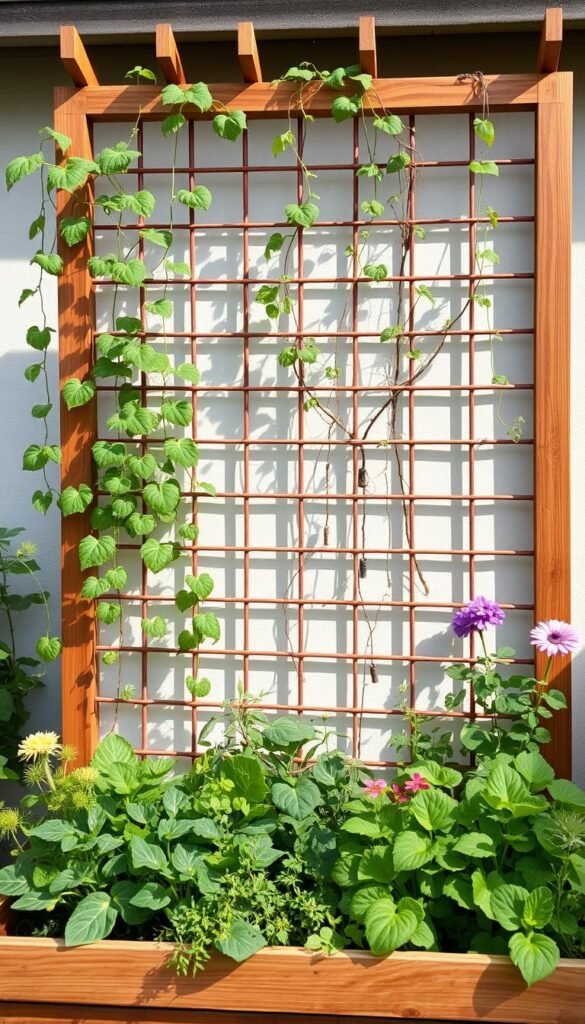Transform your outdoor area into a lush paradise without sacrificing precious square footage. Imagine growing juicy tomatoes, crisp cucumbers, and vibrant flowering vines in a setup that saves space while adding eye-catching structure to your yard. This smart approach combines two gardening essentials to create a powerhouse system for climbing plants.
Elevated planters give you better control over soil quality and drainage, ensuring your greens thrive from day one. Pair them with sturdy trellis supports, and you’ll create natural pathways for beans, peas, and other climbers to reach sunlight. The result? Healthier growth patterns and doubled harvests compared to traditional ground planting.
Even small patios or urban balconies can become productive growing zones with this method. Weather-resistant materials like powder-coated steel ensure your framework lasts through seasons, whether you’re nurturing annual blooms or perennial favorites like clematis. Maintenance becomes a breeze thanks to waist-high access—no more kneeling or straining your back.
Beyond practicality, these vertical systems add architectural charm to your landscape. Train flowering vines to cascade over geometric designs, turning functional supports into living art pieces. You’ll maximize every inch of your plot while creating a habitat that butterflies and pollinators adore.
Getting Started with Your Raised Garden Bed and Trellis
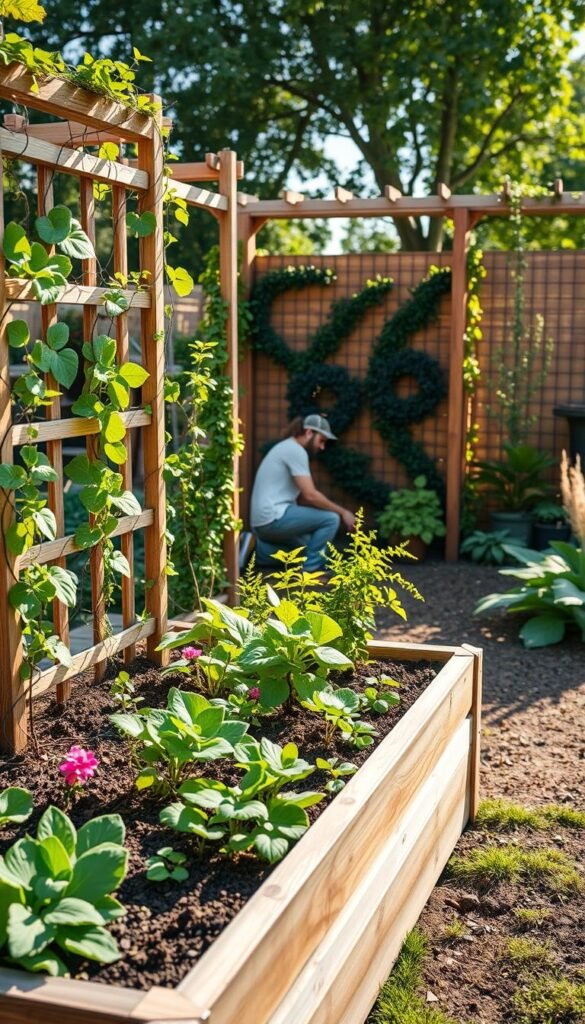
Smart preparation turns limited plots into thriving green zones. Start by sketching your ideal layout, keeping sun patterns and foot traffic in mind. The right setup balances beauty with functionality, letting greenery climb upward while keeping pathways clear.
Planning Your Space and Materials
Measure your garden area three times—once for sunlight hours, again for water access, and finally for maintenance space. Rot-resistant cedar beds paired with powder-coated steel frames withstand rainy seasons. Choose materials that match your climate: composite lumber resists moisture in humid zones, while galvanized metal suits windy spots.
Calculate bed height based on what you’ll grow—12-inch depths work for herbs, while 18 inches support deep-rooted tomatoes. Leave 2 feet between structures for easy harvesting. Your trellis type matters: lightweight mesh for peas, heavy-duty grids for melons.
Understanding Vertical Gardening Benefits
Growing upward slashes pest issues—no more nibbled cucumber leaves lying in mud. Air circulates freely, reducing mold risks. You’ll spot ripe beans faster at eye level, saving time during harvests.
Vertical systems create warm microclimates, letting you plant earlier in spring. They also protect plants from rabbits and ground beetles. Bonus? These living walls become natural privacy screens as vines fill their frameworks.
Selecting the Right Plants for Vertical Growth
Your vertical growing system becomes a living calendar, bursting with fresh produce through spring, summer, and fall. Timing your plantings to match temperature shifts unlocks continuous harvests while preventing overcrowding.
Seasonal Climbing Vegetables and Vining Plants
Cool spring days (40°F-60°F) call for sugar snap peas and snow peas. These frost-tolerant starters climb eagerly up mesh supports. As mercury rises to 70°F-80°F, transition to pole beans and cherry tomatoes that soak up summer sun.
When heat waves hit (90°F+), heat-loving malabar spinach and yard-long beans take over. Their thick leaves protect fruits from sunscald. For late-season color, try scarlet runner beans—they bridge cool and warm growing seasons beautifully.
Choosing Climbers That Suit Your Climate
Match your selections to local humidity and rainfall patterns. Coastal gardeners might opt for mildew-resistant cucumbers, while arid regions favor drought-tolerant luffa gourds. Check your USDA zone for frost dates affecting vining plants.
Extend harvests through succession planting. Sow fast-growing sweet peas after spring crops finish. In hot climates, Armenian cucumbers outpace standard varieties, producing crisp fruits all summer.
Building Your Raised Bed and Constructing a Sturdy Trellis
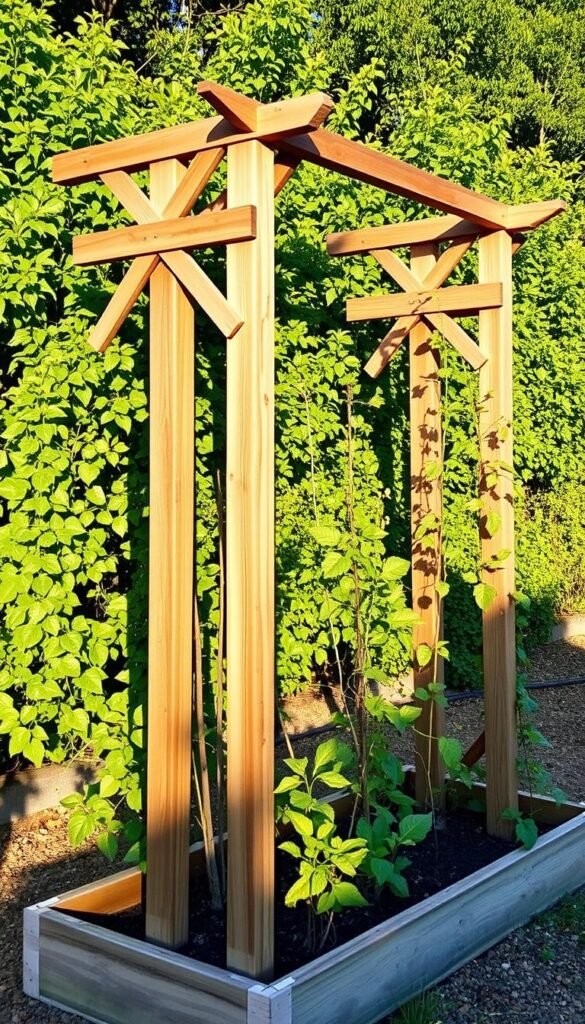
Creating a robust growing system starts with smart construction choices. You’ll need a stable foundation for your plants and supports that handle vigorous growth. Let’s break down the essentials for lasting results.
Constructing a Stable Base with Deep Soil
Your plants’ success begins underground. Aim for 12-18 inches of nutrient-rich soil to support thirsty climbers like squash. Deeper beds prevent root crowding and improve water retention during summer heat.
Choose materials that match your climate. Cedar or pressure-treated wood resists rot in damp areas. Pair beds with galvanized steel corners for extra stability. Avoid shallow setups—tomato roots can dive 3 feet deep!
Installing Reliable Trellis Supports
Livestock panels transformed into vertical supports handle heavy yields. Cut 16-foot panels in half and secure them to t-posts driven 2 feet deep. This creates an 8-foot arch that supports 30-pound melons.
For smaller spaces, attach welded wire fencing to wooden frames. Position structures on north or south sides of beds to maximize sunlight. East-west placements create unwanted shade.
“A well-built trellis should withstand tugging from enthusiastic pumpkin vines and summer storms alike.”
| Material | Best For | Installation Tip |
|---|---|---|
| Livestock Panels | Heavy fruits | Space posts 4 feet apart |
| Welded Wire | Quick-growing greens | Use rust-resistant staples |
| Galvanized Steel | Wet climates | Pre-drill mounting holes |
Allow 2 feet between structures for easy access. Check connections seasonally—tighten loose screws before plants reach full weight. Your future self will thank you during harvest time!
Optimizing Sunlight, Soil, and Watering for Success
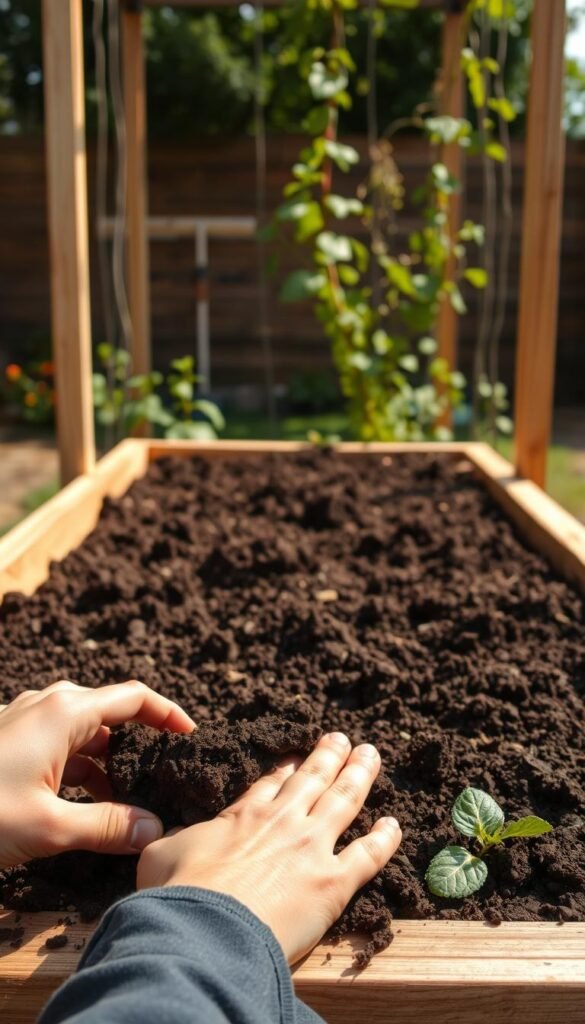
Your green thumb meets smart science when optimizing growing conditions. Three factors determine whether your climbers thrive or merely survive: light exposure, root space, and hydration. Nail these elements, and you’ll watch your green investments pay dividends all season.
Soil Preparation and Deep Nutrient-Rich Layers
Sunlight acts as nature’s growth accelerator. Aim for 8+ hours of direct exposure daily—position structures where morning rays hit first. Some varieties like malabar spinach tolerate 6 hours, but fruiting plants demand maximum light.
Depth matters more than you think. A 50-square-foot bed with 18-inch soil yielded 145 pounds of produce in trials. Shallow 6-inch setups force roots to compete, while deep layers let them spread 3+ feet outward. Skip weed barriers—they strangle expansion.
Build your soil like a layer cake:
- Compost base for microbial activity
- Loamy middle layer for moisture control
- Top dressing of aged manure for slow-release nutrients
Watering needs shift dramatically with depth. Surface-level roots in shallow beds beg for daily drinks, while deep systems store moisture like reservoirs. During dry spells, soak beds thoroughly twice weekly—early mornings prevent evaporation.
“Plants in deep soil develop drought-resistant roots that tap into underground moisture banks you didn’t know existed.”
Mulch becomes your secret weapon against thirsty afternoons. A 3-inch straw layer cuts watering needs by 30% while keeping soil temperatures stable. Watch melons plump up and beans climb faster when their roots stay happily hydrated.
Training and Caring for Your Climbing Plants
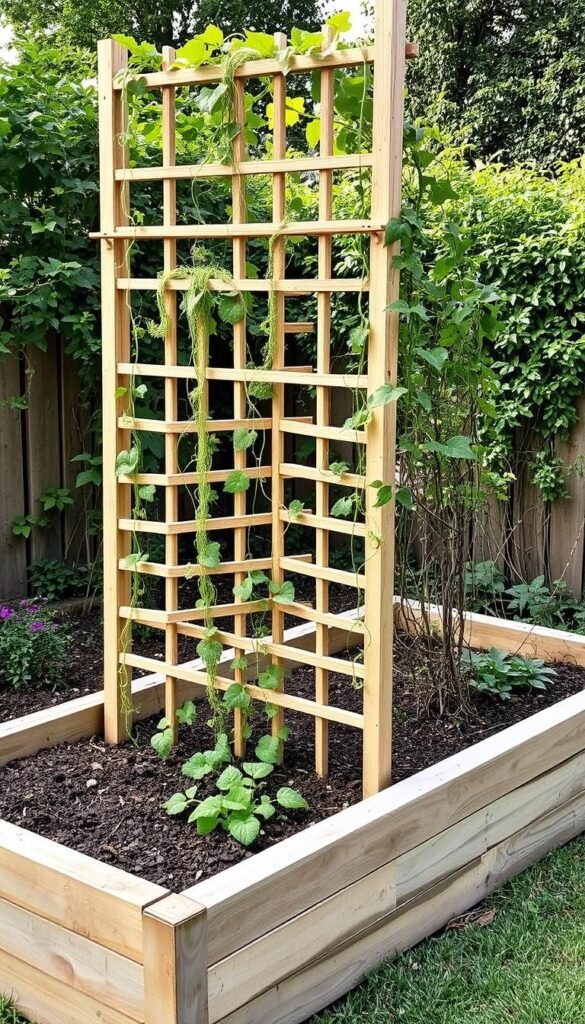
Mastering plant training techniques transforms your vertical setup from good to exceptional. Proper guidance ensures your green investments grow upward efficiently while bearing impressive yields.
Tying Vines and Pruning for Maximum Growth
Fast growers like watermelon shoots expand 1-2 feet weekly. Their natural tendrils often fail during storms. Use surveyor’s tape to create loose figure-8 loops below leaf joints. This method secures stems without cutting circulation.
Pruning strategies matter. Unlike tomatoes, watermelons thrive with multiple vines. Allow every healthy stem to climb—they’ll produce more flowers and fruits. Trim only damaged sections to maximize harvest potential.
Using Slings and Support Systems for Heavy Fruits
Fruits over 2 pounds need reinforcement. Repurpose nylon stockings or mesh bags as custom slings. Secure them directly to the trellis, not the vines, to prevent stem damage.
| Material | Weight Capacity | Reusability |
|---|---|---|
| Nylon stockings | 5-8 lbs | Single season |
| Mesh produce bags | 10-12 lbs | 3-4 seasons |
| Canvas strips | 15+ lbs | Multiple years |
“A well-supported watermelon grows plumper than its ground-grown cousins—the trellis keeps fruits clean and sun-kissed.”
Check ties weekly as plants gain weight. Adjust sling positions as fruits expand. This hands-on approach prevents snapped vines and lost crops during growth spurts.
Raised Garden Bed with Trellis: Vertical Solutions for Vines and Climbers
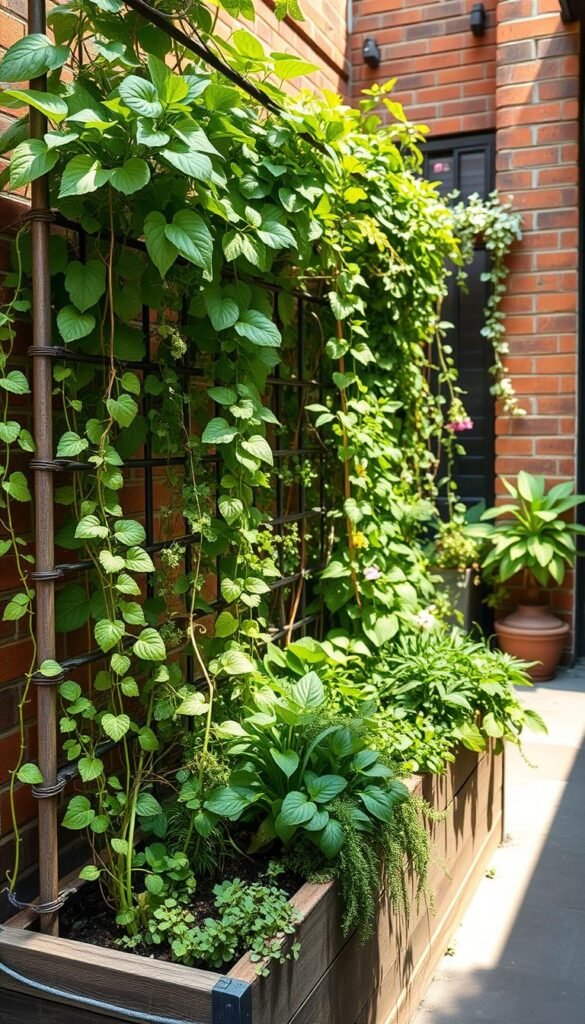
Urban growers are redefining what’s possible in tight quarters. Imagine cultivating a sprawling watermelon plant in just 16 square feet—a feat requiring 225% more ground space traditionally. This efficiency isn’t magic; it’s the power of upward growth strategies.
Benefits of Vertical Gardening in Small Spaces
Your compact area becomes a productivity powerhouse. Vining crops like melons climb instead of sprawling, freeing precious square footage for herbs or flowers. Studies show vertical systems yield 2-3 times more per square foot than traditional rows.
Maintenance gets easier when plants grow at waist level. No more crouching to inspect leaves or harvest beans. Better air flow reduces mildew risks, while elevated positioning deters ground pests naturally.
- Grow 8+ varieties in space once holding 3
- Rotate crops faster with staggered planting
- Create microclimates for heat-loving species
“Vertical setups let me grow enough tomatoes for canning on a balcony that barely fits two chairs.”
These systems double as living decor. Flowering peas add vertical interest to patios, while pole beans form edible privacy screens. Even shaded corners work—train spinach vines up north-facing supports.
| Space Saved | Traditional Method | Vertical Approach |
|---|---|---|
| Watermelon | 15-foot circle | 4×4 foot bed |
| Cucumbers | 10 sq ft | 2 sq ft |
| Pole Beans | 6-inch rows | 18-inch tower |
Your garden gains year-round functionality. Install removable frost covers on frames for winter greens. Come spring, swap them for seed-starting racks. Every inch works smarter, not harder.
Exploring Innovative Trellis Designs and Plant Supports
Your plant supports can be both practical and artistic. Beyond basic functionality, creative frameworks turn climbing plants into living sculptures while boosting yields. Let’s explore materials and designs that blend strength with style.
Using Livestock Panels, Wood Frames, and Fencing
Livestock panels shine for heavy-duty needs. Cut them into arches or grids, then anchor with T-posts for melons and winter squash. Pair treated wood frames with wire fencing for lighter climbers like peas—this combo lasts 5+ seasons with proper care.
For tomatoes, cages made from galvanized steel prevent rust stains. Space horizontal wires 8 inches apart to support branches as fruits swell. These supports work double duty—train indeterminate varieties upward while keeping foliage dry.
Creative Ideas for Decorative and Functional Supports
Transform plain structures into focal points. Bend copper pipes into spirals for flowering vines, or arrange bamboo poles as geometric towers. For small-space growers, square foot gardening pairs perfectly with vertical panels that maximize every inch.
Match your support type to plant personalities. Delicate sweet peas thrive on lattice screens, while climbing roses need sturdy pergolas. Use removable trellises on planter boxes—swap designs seasonally without disturbing roots.

